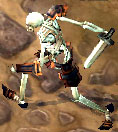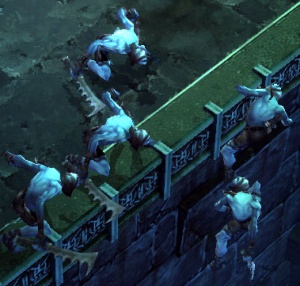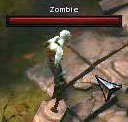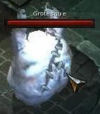Difference between revisions of "Undead"
(→References) |
(→Incorporeal Types) |
||
| Line 60: | Line 60: | ||
==Incorporeal Types== | ==Incorporeal Types== | ||
| − | A great deal of undead comes in incorporeal forms, such as [[Wraith]]s. This type of undead is the ectoplasmic manifestation of a soul that chose to stay in the mortal realm after losing its normal life, a spirit that has been forced to stay through magic, or perhaps pulled in to the mortal realm from the spirit world. Depending on the type, they usually require weapons of magical nature to damage, and they are experts in draining speed, energy or | + | A great deal of undead comes in incorporeal forms, such as [[Wraith]]s. This type of undead is the ectoplasmic manifestation of a soul that chose to stay in the mortal realm after losing its normal life, a spirit that has been forced to stay through [[magic]], or perhaps pulled in to the mortal realm from the spirit world. Depending on the type, they usually require weapons of magical nature to damage, and they are experts in draining speed, [[mana|energy]] or [[life]] from anyone that would have a close encounter with them. |
<br> | <br> | ||
<br> | <br> | ||
Revision as of 17:15, 27 January 2009
Undead is one of the three classifications of monsters in Diablo II. All monsters belong to one of the classifications in Diablo II, and certain spells or items are more effective against different types of monsters.
It's not known if these classifications will return in Diablo III, but we're using it since it's a convenient way to sort things, until official information is released.
The classifications of monsters we use in Diablo III are:
- Animals (category) - Feral, unintelligent enemies.
- Demons (category) - Mostly Sinister, sentient monsters from Hell.
- Objects (category) - Stationary obstacles, like traps.
- Undead (category) - Varying types of re-animated corpses, mostly from humans.
For a full list of Undead monsters, check out the Undead Category. You can also go to the Diablo 2 Wiki to the find Diablo 2 Undead.
Contents
Undead
The Undead classification is for several types of corpse or skeleton reanimation. A Witch Doctor or Necromancer is capable of summoning undead monsters to help him in battle without touching demonic magic, but mostly it refers to enemies of the player. The undead monsters vary greatly in appearance and intelligence.
The demonic undead belong to the realm of influence of Mephisto, who specializes in perverting the dead into macabre creations of undeath.
Skeletal Types

There are also truly powerful skeletal undead, like King Leoric, which is infused by the power of his tormented soul in addition to dark magic.
- Read more about this type of undead in the Skeleton article.
Corpse Types

Ghouls
Ghouls are some sort of reanimated corpse but nothing like slow shambling zombies; the ghouls are fast and uncanny, running hunched over in a bestial, almost quadrupedal style. They climb quickly and leap out at the player from all angles, scaling a huge wall to get into the action. They seem somewhat intelligent in that they can also wield weapons, such as swords.
Zombies

Zombies are generally completely void of intelligence, and the wounds they received prior to their death often slows them down, making them dangerous primarily only in large numbers. They are the most basic sort of undead, often thought of as even less troublesome than Skeletons. The one thing they have as an advantage is usually that they can take more physical punishment before they are destroyed, and the force or spirit that drives them is removed/expelled.
Mummies
Mummies are usually powerful warriors or kings stored in great tombs of the Sanctuary desert tombs, and when reanimated, they will react similar to Zombies. The difference is their power and capabilities of spreading disease easier. No mummy type enemies have been announced for Diablo III yet.
Construct Types

Incorporeal Types
A great deal of undead comes in incorporeal forms, such as Wraiths. This type of undead is the ectoplasmic manifestation of a soul that chose to stay in the mortal realm after losing its normal life, a spirit that has been forced to stay through magic, or perhaps pulled in to the mortal realm from the spirit world. Depending on the type, they usually require weapons of magical nature to damage, and they are experts in draining speed, energy or life from anyone that would have a close encounter with them.
Higher Undead
Most general types of undead never reach a point where they are truly sentient, and even then, they are usually slaves to some sort of master that resurrected them. However, if enough dark magical power is infused in a corpse, skeleton or a skeletal construct, they can attain sentience, and even outdo their former master. Examples of this is classically Liches or Vampires, who often in turn raise lower undead as servants and guards.Besides King Leoric, no other "Higher" undead has been announced for Diablo 3.
References
- Writings of Abd al-Hazir: Entry no. 0008
- Diablo I Manual
- Diablo II Manual
- Diablo II: Lord of Destruction Manual
- Diablo 3 Artwork: Monsters
- Diablo 3 Screenshots
- Diablo 3 Gameplay Shots
- Diablo 3 Cinematic Shots
| Monsters of Diablo III[e] Beasts Beasts: Superunique Demons Demons: Superunique Humans Humans: Superunique Undead Undead: Superunique Objects Bosses Boss Mods Monster Info Fanmade |
|---|
| Beasts | Bat - Beast - Blood Hawk - Demonic Hellflyer - Electric Eel - Khazra - Lacuni - Lamprey - Quill Fiend - Rockworm - Sand Monster - Sand Shark - Sand Wasp - Scavenger - Spider - Spiderling - Swarm - Withermoth - Wood Wraith - |
|---|
| Demons |
Armored Destroyer - Dark Berserker - Deceiver - Fallen - Ghoul - Hellion - Thrall |
|---|
| Undead |
Accursed - Bone Reaver - Brigand - Dune Dervish - Ghost - Ghoul - Grotesque - Morlu Caster - Risen Dead - Skeleton - Skeleton Mage - Unburied - Wraith - Wretched Mother |
|---|
| Primary Quest Uniques |
Act One Bosses:
Araneae -
Skeleton King -
The Warden -
The Butcher
|
|---|
|
| |||||
|---|---|---|---|---|---|
| Uniques Modifiers |
Strong CC (Limit 1): Knockback -- Nightmarish -- Vortex -- Jailer | ||||
| Removed Modifiers |
| ||||
|
| |||||
| Act One Uniques | Araneae - Web Spit | Leoric - Summon Skeleton, Teleport Strike, Triple Cleave | The Butcher - Smash, Grappling Hook, Spear, Frenzy Charge | ||
| Act Two Uniques | Maghda - Forcefield, Summoning Ritual, Punish, Moth Dust, Teleport. | Zoltan Kulle - Fiery Boulder, Time Bubble, Ceiling Collapse, Energy Twister,Vanish, Creepy Laugh | Belial - Phase One: Triple Fireball, Summon Vipers. Phase Two: Poison Meteors, Ground Pound, Lightning Strike, Lightning Breath. | ||
| Act Three Uniques | Ghom - Acid Slime, Sneeze, Gas Cloud, Chomp. | Siegebreaker - Triple Hit, Charge, Leg Stomp, Grab and Throw. | Cydaea - Pain Bolts, Web Trap, Spider Pits. | Azmodan - Bellyflop, Laser Attack, Falling Corpses, Demon Gate, Pool of Destruction, Globe of Annihilation. | |
| Act Four Uniques | Rakanoth - Cleave, Teleport Strike, Blade Strike, Volley, Summon Minion. | Izual - Frost Nova, Frozen, Summon Minions. | Diablo - Phase One: Claw Rip, Charge, Hell Spikes, Shadow Vanish Grab, Curse of Destruction, Ring of Fire, Ground Stomp, Curse of Anguish, Curse of Hatred. Phase Two: Shadow Clone. Phase Three: Overdrive, Lightning Breath. | ||
| Monster Info |
Monsters Basics -
Bosses -
Boss Modifiers -
Champions -
Quest bosses -
Teeth of Diablo -
Fan-made monsters
|
|---|
